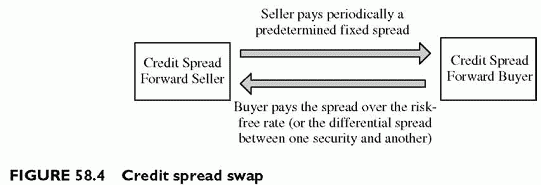BASKET SWAPS AND FIRST-TO-DEFAULT
Category: Risk Management in Banking
Basket swaps refer to portfolios of asset defaults rather than single asset credit events. The main characteristic of a basket credit derivative relates to the first-to-default concept.
The first-to-default event is the default event of any one asset in the basket, and triggers the derivative as long as it belongs to the basket.
Such characteristics raise the correlation paradox issue. Diversification should intuitively reduce the risk of the basket. In fact, it does so for the basket but not for the derivative. The probability of triggering the derivative is higher than for a single asset. The derivative does not offer protection for a single asset, but for several, by definition, since any default triggers the protection. This suggests that such protection is indeed riskier for the seller than a protection limited to a single reference asset. Second, it is possible to model the phenomenon along the lines applying to the loss distribution of a portfolio.
If we have two independent assets of default probabilities 1% and 2%, their survival probabilities are 1 minus the default probability, or 99% and 98% respectively. The probability that both survive is simply 98% x 99% = 97.02% if the events are independent. The joint default probability is 1% x 2% = 0.02%. The probability that any one of the two assets defaults is therefore 1 — 97.02% = 2.98%. This is higher than any one of the two single default probabilities. This demonstrates that the risk of first-to-default baskets is greater than for single assets, and shows that the credit risk of a basket depends on the survival probability of all assets in the basket, with or without correlation.
Correlation effects are counterintuitive in this case. A low correlation helps diversify away some of the portfolio risk, and conversely a high correlation increases the portfolio risk. However, the correlation paradox is that a high correlation increases the risk of the basket but decreases the risk of the basket derivative! Again, simple arithmetic with two assets will make this clear. Lets now assume correlated defaults instead of considering them independent. The joint default probability increases above that of independent default events. Under independence, the joint default risk is 1% x 2% = 0.02%. Under correlation, the basket derivative does not default if neither of the two assets defaults. We use the same calculations as for the borrower-guarantor joint default probabilities, to find out the probability that both survive. With a correlation between defaults of 10%, the joint default probability becomes 0.159%, instead of 0.02% under independence. It is consistent with the higher risk of the basket due to correlation. However, the risk of the derivative depends on the survival probability of both. The probability that the riskier asset alone defaults is 1.841% (less than 2% because it is conditional on the survival of the other) and the probability that the other one defaults is 0.841% (again lower than 1%). The survival probability of both is 1 — 0.159% — 1.841% — 0.841% = 97.159%. The probability that any one of them defaults is 1 — 97.169% = 2.841%, which is lower than the above 2.98%. Correlation effectively decreases the risk of the basket derivative although it increases that of the basket.
This analysis explains the rationale for such derivatives. From the protection buyers standpoint, there might be very large exposures of high-grade obligors to hedge. Putting them together makes sense. From the protection sellers standpoint, there is some comfort in finding high-grade exposures in the basket. In fact, the portfolio of high-grade exposures has a lower credit quality in terms of first-to-default. Nevertheless, it remains an eligible investment in low-risk assets with an enhanced return compared to that of individual high-grade assets. However, the return should, in theory, be in line with the true economic risk.

